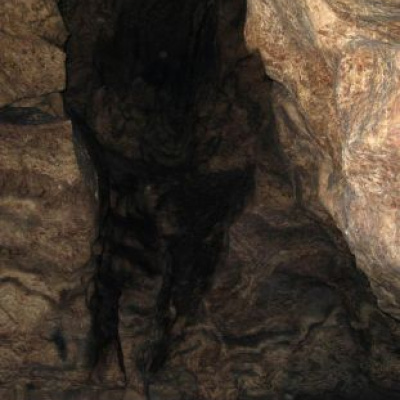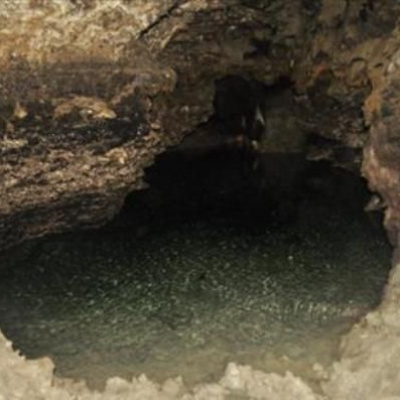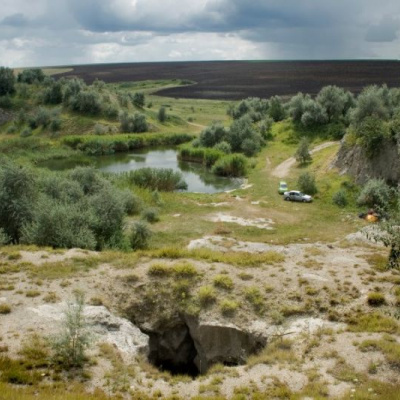Bukovynka is a karst cave, a geological (karst and speleological) natural monument of national importance in Ukraine. Bukovynka is located 1.5 km southwest of the village of Stalnivtsi in the Novoselytsia district of
Chernivtsi region. The area of the natural monument is 5 hectares, the status has been granted since 1981. It is part of the
Vyzhnytskyi National Nature Park. In the Novoselytsia district, near the village of Podvirne, there is another interesting cave -
Cinderella.
Bukovynka is one of the largest caves in Bukovyna. It was discovered in February 1976 in the wall of an abandoned gypsum quarry. It was explored in 1979 by Chernivtsi speleologists. It consists of two caves: Bukovynka-1 and Bukovynka-2, which have separate entrances and corridors, but are hydrodynamically connected, as they belong to the same karst massif within the Podilsko-Bukovynska karst area.
The cave is a three-story labyrinth with a total length of over 5 km. The lower floor is almost completely flooded. The passages of the upper floor are narrow, the middle (main) floor is wide and relatively high - 2-3 m wide on average, 1.5-5 m high. It was here that stalactites were first found in Bukovyna; there are also many different natural forms and secondary crystals. The passages of the lower tier have a low vault. Several lakes with mineralized water were also discovered. In winter, ice stalactites and stalagmites form at the entrance to the cave. The cave is a shelter for bats.
Bukovynka can be used for scientific and health resort purposes, as well as for the development of speleotourism. It is protected by law as a geological natural monument of national importance.
The first speleological study of the cave was conducted by V. Korzhyk in March 1976. It is comprehensively studied by Chernivtsi speleologists. The cave was formed in the upper thickness of gypsum of the Badenian regional level (14 million years old). The cave is of labyrinth type, consists of 3 floors, the lower one is watered. The main floor is the middle floor with main galleries of different morphology (average width of passages - 2-3 m, height - 1.5-5 m). The upper floor is fragmented and consists of narrow slits of small labyrinthine sections connected to the middle floor through vertical wells or high halls.
The topographically studied length of the cave passages is 5287 m, the amplitude is about 15 m, the area is 8518 m2, and the volume is 13 490 m3. The microclimatic conditions inside the cave are thermoconstant. The average annual temperature is +10 °C, relative humidity is 99%. There are numerous secondary crystalline and natural formations in the cavity. The cave is distinguished by its taphonomic richness - osteological remains of a cave bear, horse, common deer, rhinoceros, primitive bison (bison) and other animals. The cave is inhabited by several species of bats, which form large (up to several hundred) colonies during winter. The most common species is the bat, as well as the big noctule. In the waters of siphon lakes, a species of troglobiont bokoplav, as well as other troglobiont and troglophilic invertebrates, has been found. Bukovynka is important as a research site for speleocarstological, speleobiological, paleogeographical and speleomedical research.
A memo about Bukovyna caves
- Ukrainian lands have a lot of mysterious and unknown things, but there are even more secrets underground. There are mysterious caves that have played an important role in history for the locals. Some of them were inhabited by monks, some served as hiding places for rebels, and other cave passages still keep secrets.
- More than 130 caves are already known in Bukovyna. They are different: vertical, horizontal, small and large, with underground lakes and rivers - each one is unique. One can be 5 meters long, and, for example, the Cinderella Cave is over 90 km long. However, there are only three large caves longer than one kilometer: Cinderella and Bukovynka (5.5 km) in the Novoselytsia district and the Chornopotocka cave (1 km and 5 meters long) in the Zastavna district.
- A cave hyena's lair was found in one of the caves in Bukovyna. There are also remains of animals that were preyed upon by the hyena: bison, cave bears, horses, and deer. They are approximately 42 thousand years old.
- There are a number of caves in the Dniester basin where monks once lived. There are over a hundred such cave hermitages and monasteries. Most of them appeared in the sixteenth and seventeenth centuries. Occasionally there are cells of the twelfth century, the time of Kyivan Rus.
- There are about ten such cave complexes in the Chernivtsi region, for example, the Neporotiv (Galician) Monastery in Sokyryany district, the village of Babyn in Zastavna district has the remains of cells, and the village of Vasyliv has traces of a monk's residence, and even on the territory of the Dniester PSPP, the remains of cells were found in the rocks. The Halychyna St. Nicholas Cave Monastery is still in operation today.





